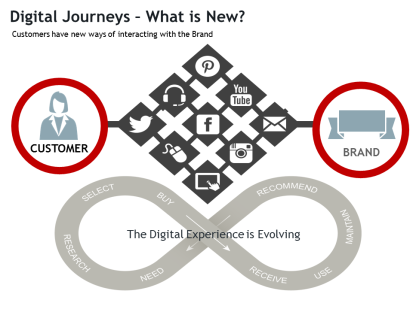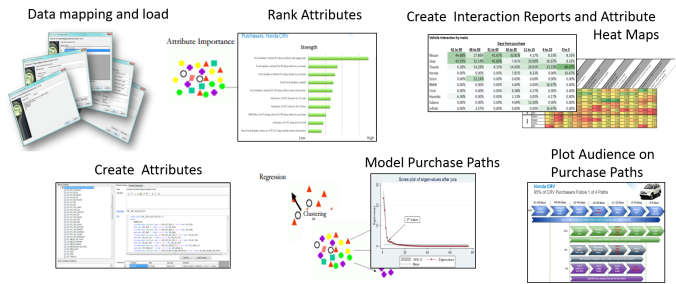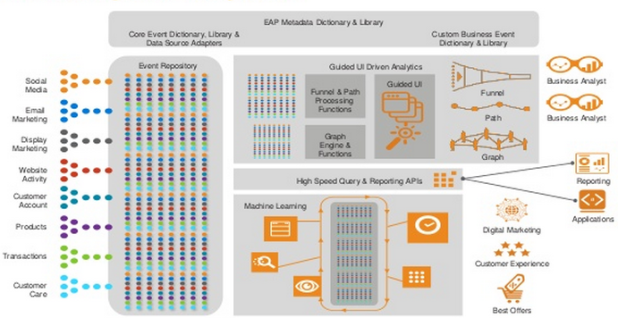Customer Journey Analytics and Data Science
 Where do customers abandon the shopping process? Is it the same in every geography?
Where do customers abandon the shopping process? Is it the same in every geography?- Audience of One…. Who are your fans versus haters in the marketplace?
- How do customers feel about your products? How engaged are customers with your brand versus your competitors’ brands across social media and web channels?
Fortune 500 companies are making large investments around Programmatic Marketing, Sales and Service (“marketing that learns”). Programmatic marketing is the application of automated technology through which media buyers and sellers may align organizational processes in support of ongoing, channel-agnostic customer engagement (and to allow for the continuous optimization of that effort as business strategies evolve) in order to drive revenue.
One of most often implemented use case in Programmatic Marketing is customer journey mapping and analytics.
Why? Because, deciphering the nuts-and-bolts” of individual customer journeys online (and deducing intent) is core to improving customer experience and driving brand loyalty.
Specifically, the objectives are:
- Visualize and map the end-to-end customer journey by personas
- Optimizing on the right journey attributes to increase yields by >30% lift… Uncover the right combination of web, mobile and physical channels, content and experiences that best achieves the target goals
- Enable marketers to identify journey bottlenecks for individuals and aggregates
- Leverage actual behavior data to enhance and personalize the experience for each individual customer
To facilitate cross-channel marketing, sales, commerce or service, companies must be able to connect all the dots in order to see the ‘big picture’ of how customers interact with them across channels and touch points. Customer Journey Analytics helps organizations know where customers have been, what they’re trying to achieve, and why specific issues led them down a particular channel.
Many customers use an average of five different channels to contact companies and service providers. They switch quickly from web, to telephone, to social media, to chat, to interactive voice response, to visiting a retail location, depending on whichever is most convenient at the moment, all while expecting the company to remember what they said and did over several of their past interactions.
Yet companies as a whole, and divisions such as marketing, sales, and service, manage each of these channels as silos, optimizing the customer experience for each channel independently but losing track of the customer’s overall journey as they jump from channel to channel. A significant part of the problem is fragmented data… product, sales, campaign and customer data was managed by multiple divisions, agencies and vendors.

According to recent Mckinsey Research, “organizations able to understand and skillfully act on complete customer journeys can reap enormous rewards: increasing customer satisfaction by up to 20 percent and revenue growth by 10 to 15 percent, and lowering the cost to serve by 15 to 20 percent.”
Customer Journey Analytics and Data Science
Given the myriad of paths that each journey can take as customers move between different channels over time, identifying which paths led to growth, customer loyalty and satisfaction is a data science challenge.
A new breed of customer journey analytics solutions are emerging that uses predictive and real-time analytics as well as machine learning (ML) technologies to identify customer behavior patterns and help determine customers’ next move, likeliness to churn, or interest in a particular product or offer. Organizations can use this information to personalize the customer experience in real time by deciding which offers or messages to present to a customer while an interaction is taking place.
Path analysis allows organizations not only to focus on the individual journey but also to understand the impact of the thousands of journeys that take place each day. By analyzing and monitoring cross-channel paths, companies can detect important insights about groups of people who exhibit a similar pattern of behavior. This could identify problems and opportunities that might once have gone undetected.
The Data Science Challenge in Journey and Path Analysis
The beauty of data science is that you can target a “who”, rather just focusing on “where.” A “where” is just a placement, something you can buy (ad placement) and know that you are going to get 100% share of voice on that page, no matter who is visiting. This is a spray-and-pray approach. There is waste in that, because many visitors may not be in the target demographic. In other words, just because people are visiting that digital property does not mean they are the type of consumer you need to talk to. With the extra layer of data and insight you get with analytics, you can actually decide who you’re going to engage with and who you need to speak to.
However, this is not easy. There are millions of attributes to collect, aggregate, monitor in a customer journey. The modeling challenge is to know which ones are predictive of opportunity and cost?
- Combination
- Weight
- Order
- Timing
- Execution Context
How can one predict with 95% precision the Path to Purchase? A good data science team would build and improve models that can segment and score customers down to the individual level isolating the most critical attribute to take action upon based on thousands of behavioral attributes.
Summary
Every major vendor – IBM, Salesforce.com, Oracle – is pushing new products and platforms that enable Customer Journey and Path Analysis.
Why? Because there is a shift happening in many marketing organizations from focusing on moments of truth to customer journeys. Customer journeys are a discreet set of interactions a customer has with a brand around a need.
Understanding and addressing those journeys creates real value for managing customer experience and engagement, much more so than improving the performance of individual touchpoints. The end-to-end process matters.
According to recent Mckinsey Research, “By combining deep data analysis and ethnographic research, digital leaders can identify high-value microsegments, such as new mothers with full-time jobs who primarily shop online. Understanding how these customers make decisions—how they shop, for example, or what influences them—allows digital leaders to tailor their approaches. One major bank unlocked more than $300 million in profitability by tapping into underutilized customer data and delivering targeted marketing messages at various points in the purchase-decision process. The bank used the data to inform changes in marketing campaigns.”
Additional Notes and References
- Digital Personas and “A Day in the Life Of” — disruptivedigital.wordpress.com
- Mobile Marketing Engagement – Path to Purchase – disruptivedigital.wordpress.com
- Digital Transformation
- Big Data Use Cases
- Customer Experience Index – How to create a score that illustrates the customer experience. Many firms are going beyond reporting (web analytics) and doing more predictive analytical models (allows you do drill-downs into what happened, but also why and what to do).
- Good presentation to review … Customer Journey Analytics and Big Data from McKinsey Chief Marketing & Sales Officer Forum
- Applications deliver the company’s brand and customer experience… The entire ecosystem of applications combine to deliver the full customer experience…unfortunately, today they are mostly designed in a silo’d manner… Applications are not effectively integrated to solicit and extract customer experience data well… Effective architecture shown below enables the considerations for obtaining and delivering information about the customer experience
Trackbacks & Pingbacks
- VKBD – Customer Journey Analytics and Data Science
- Digital Marketing + Data Science = Programmatic Marketing | Digital Transformation, Engagement and Experience
- Big Data, Analytics and KPIs in E-commerce and Retail Industry | Business Analytics 3.0
- Customer Journey Analytics and Data Science | A bunch of data









Reblogged this on What's the Big Data Idea and commented:
Excellent analysis of the customer experience.
LikeLike
Well written professional article with good stuff! I like how the author has described customer’s actions process and think that this kind of analytic has good chances to be named better that its competitors. The only thing I’d like to add which displays technical side of the process is using virtual data room for viewing and checking all necessary documentation.
LikeLike
Great post. This is a really good example of the emerging methodology of “journey science”, where journey analytics and data science meet. At the heart of journey science is having a dataset with all data sources connected so that all possible sequences can be analyzed using traditional analysis and data science tools.
LikeLike
Hi Ravi,
You are right, customer journey mapping really plays a great role in for smooth customer experience. One need to offer easy and simple way to navigate throughout the store to be the first choice among customer. We our self as an leading e-commerce development company ensure to offer the unforgettable user experience to our clients.
LikeLike